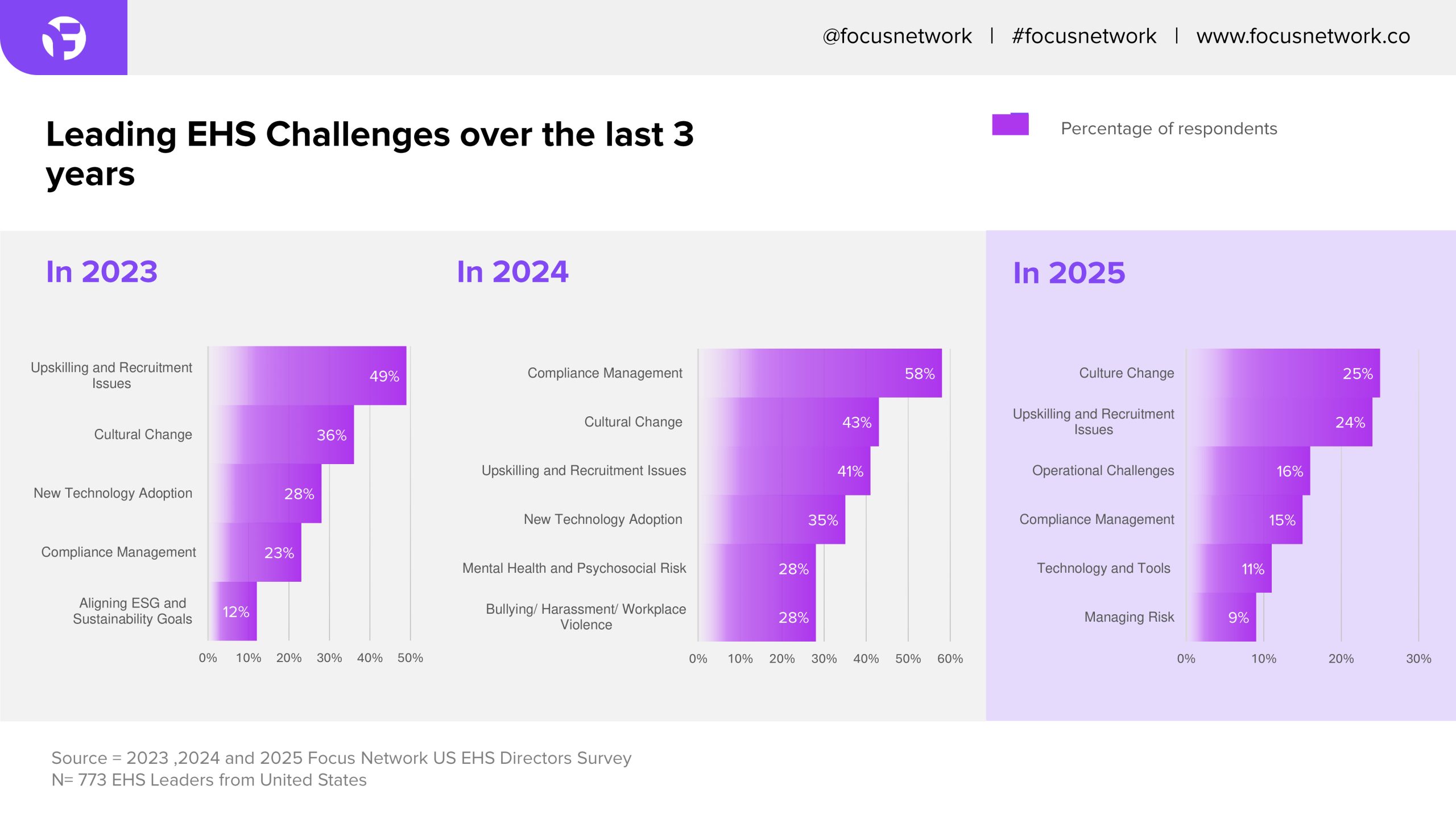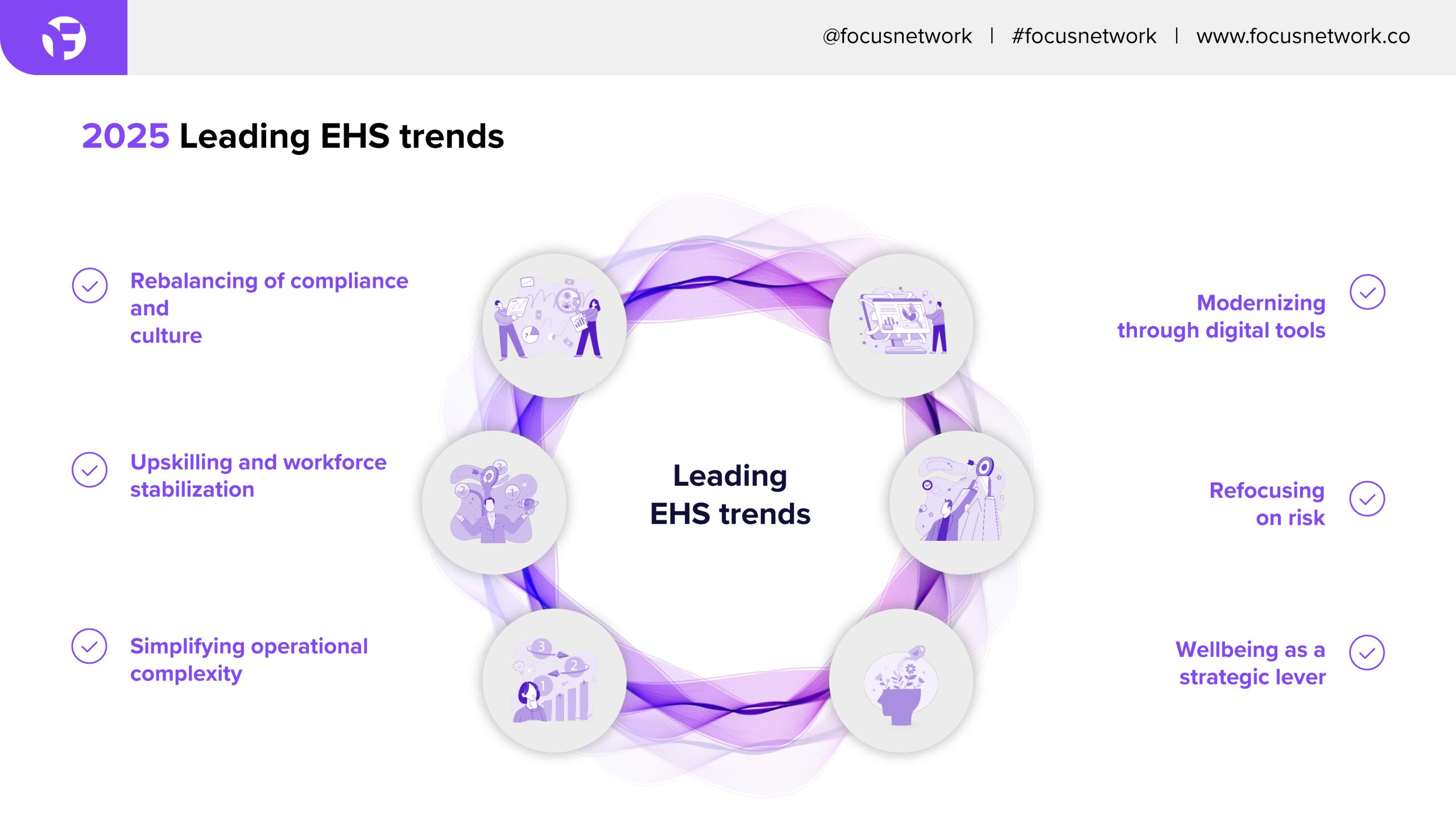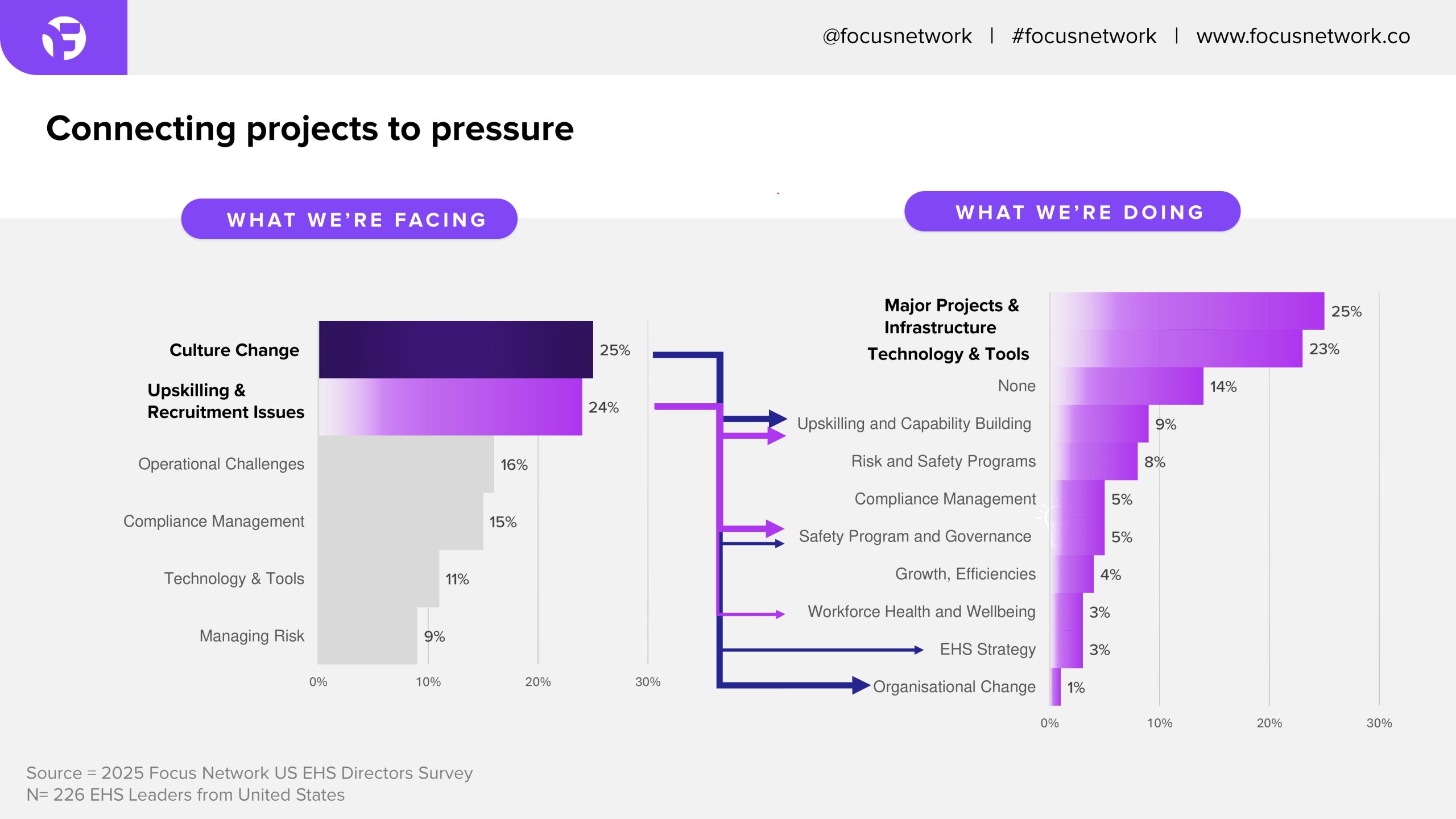Building a Culture of Safety as the Foundation for Improved Environmental, Health & Safety Performance
The Cultural Imperative in EHS
In today’s complex EHS landscape, “culture” has emerged not just as a buzzword but as a critical determinant of performance, resilience, and workforce safety.
Tyron McGurgan, Founder & CEO of Focus Network, recently presented the organization’s latest research findings to over 200 senior EHS executives from across the United States at the biannual 5th annual EHS Leaders Summit USA, held on May 23–24, 2025, at the Sheraton Downtown in Phoenix, Arizona. The insights were drawn directly from Focus Network’s most recent national EHS Leaders Survey, which captured in-depth perspectives from 226 senior EHS executives nationwide.
One of the most prominent themes to emerge from the research is that driving a culture of Safety remains one of the top ranked challenges for the third consecutive year. However, the nature of this challenge is evolving. Whereas previous efforts centered around compliance enforcement and procedural adherence, today’s cultural concerns cut deeper, highlighting widespread issues such as middle management fatigue, employee disengagement, ineffective communication, and rising safety complacency.
Cultural Fatigue and the Strain on Middle Leadership
The 2025 research clearly outlines an alarming trend, middle managers are strained, isolated, and unsupported. This group, often tasked with executing strategy, influencing frontline behavior, and interpreting policy, has become a pressure point within many organizations. Without sufficient leadership development or engagement frameworks, they are showing signs of fatigue.
The research revealed:
- Managers feel accountable for safety outcomes but lack the autonomy and training to lead effectively.
- Communication channels are too top-down, failing to involve mid-level leaders in shaping safety strategy.
- Safety messaging often becomes diluted as it moves from senior leadership to the workforce.
Moreover, this leadership gap correlates directly with the rise in complacency and operational drift. In some cases, years of strong safety performance have led teams to lower their guard. As safety incidents become rarer, the perceived importance of safety behaviors can diminish, until a critical event brings it back into sharp focus.
Leading EHS Trends across the United States in 2025
Communication Breakdown Becomes The Culture Killer
Another defining challenge in 2025 is the failure of communication strategies. Many organizations still rely on outdated broadcast-style messaging that assumes awareness equals action. But as any modern safety leader knows, true cultural engagement must be dialogic and continuous.
The Survey data reveals that many EHS teams struggle to:
- Tailor safety messages to different roles and levels within the business.
- Provide mechanisms for two-way feedback from workers and contractors.
- Track whether communications are resulting in changed behavior.
This challenge is compounded in large, multi site, or remote work environments, where consistent messaging is difficult to maintain. The traditional “safety moment” or monthly bulletin is no longer enough to engage a digitally connected but emotionally disconnected workforce.
The Safety Culture-Investment Disconnect
Perhaps the most striking finding from the 2025 survey is the clear misalignment between the challenges and investments Health, Safety and Environment executives are facing. Although safety culture continues to be identified as a core challenge by EHS leaders in the latest data, it remains significantly underfunded and deprioritised. Shockingly, only 1% of respondents reported actively allocating budget towards improving it, highlighting a clear disconnect between recognised importance and real investment.
The data shows that:
- 25% of surveyed EHS leaders indicated Safety Culture Change to be their number 1 challenge in 2025
- Only 1% of respondents indicated they are actively investing in or implementing new initiatives to address this issue.
- Just 3% view Workforce Health and Wellbeing as a key business driver or strategic initiative.
Improving culture must start with employees feeling genuinely supported. Without the right support programs in place, both proactive and ongoing, cultural change will remain out of reach. A workforce that doesn’t feel cared for will struggle to engage, making any effort to shift the culture ineffective from the start.
This graph clearly highlights a misalignment and reveals several key indicators that explain why Safety Culture remains the number one challenge and concern for EHS leaders in 2025.
Driving an effective safety culture within any organisation must begin with clear communication, consistent messaging, and strong leadership support. It also requires meaningful programs that are backed by action, visible changes that employees can see, feel, and actively participate in. Without these foundational elements, culture remains stagnant, and true improvement becomes impossible.
These results leave us to ask some serious strategic questions, Are EHS leaders investing in what’s most urgent, or simply in what’s easiest to justify? Are we treating culture as a tangible performance driver, or as an abstract idea?
Industry-Specific Safety Cultural Challenges across the USA
The safety culture challenge is not felt evenly across all industries. In the top five sectors represented in this research Construction/Infrastructure, Manufacturing, Utilities/Oil/Gas/Energy/Mining, Transport/Logistics, and Education, the cultural context varies, but the gaps remain.
For example:
- In construction and transport, high turnover and contractor reliance make safety cultural continuity difficult.
- In manufacturing and utilities, long-tenured workers may resist new safety cultural models.
- In education, the interface between staff wellbeing and student safety creates overlapping risk profiles.
Each of these sectors requires a tailored safety cultural strategy that acknowledges its specific pressures and workforce realities.
Rebuilding Culture from the Middle Out
To address the cultural deficit, EHS leaders must rethink their approach to change management. The key lies in empowering middle leadership as cultural carriers, not just operational executors.
This involves:
- Leadership training tailored to real world safety challenges.
- Storytelling and recognition programs that elevate local safety champions.
- Feedback loops that capture worker sentiment and convert it into action.
- Decentralized communications that allow each department or site to shape the message while aligning with central themes.
The ultimate aim is to move from “safety as control” to “safety as commitment.” This requires time, consistency, and above all, investment.
The Call to Action for EHS Leaders
Safety Culture must not be looked as a side issue. It’s the single most consistent predictor of whether safety policies will succeed or fail. In the words of many senior Environmental, Health & Safety executives who were in attendance at the recent Focus Network EHS Leaders Summit 2025 in Phoenix , “If the culture isn’t right, nothing else works.”
To close the gap, EHS leaders must:
- Conduct cultural diagnostics to identify points of resistance or drift.
- Invest in leadership development for middle managers and supervisors.
- Measure culture regularly not just through incident rates, but sentiment and engagement.
- Reallocate budgets to include programs that support behavior change and cultural reinforcement.
- Treat culture as a KPI not a soft initiative.
Only by addressing safety culture as a strategic asset, not a compliance obligation, can EHS teams futureproof their organizations for the decade ahead.
About Focus Network
Focus Network is a leading provider of high-level research and advisory services, as well as tailored events for senior professionals in the Environmental, Health, and Safety (EHS) sector. We connect EHS leaders, innovators, and major suppliers to foster collaboration, share valuable insights, and drive meaningful change across industries. Through our global EHS Leaders Summits and other specialized private events, we unite experts to address the most pressing challenges in safety, compliance, and sustainability. Our approach is informed by localized insights and data, meticulously curated through our extensive research and in depth reports.
About the EHS Leaders Summit
The EHS Leaders Summit is a premier, invite-only event held annually across the United States, Australia, Singapore, and New Zealand, bringing together senior EHS executives to explore the future of workplace safety, regulatory challenges, and innovative solutions from a range of carefully selected suppliers. This exclusive summit offers unmatched networking opportunities, hands on learning sessions, and region specific insights curated by Focus Network analysts, providing an in depth exploration of the latest trends and technologies shaping the EHS sector locally in each area. Over the course of two days, attendees engage in pre-arranged 1-1 business meetings with leading supplier companies, equipping them with actionable knowledge and strategies to drive meaningful change within their organizations.
JOIN the Upcoming EHS Leaders Summit, USA
23rd – 24th September 2025, Vinoy Golf Resort, St Petersburg, Florida
Looking to join or learn more about our next EHS Leaders Summit in the United States as a delegate? (must be a senior EHS executive)
Click here: DELEGATE INFORMATION AND REGISTRATION
Looking to join or learn more about becoming a strategic supplier or service partner at our next EHS Leaders Summit in the United States ?
Click here: SUPPLIER PARTNERSHIP INFORMATION






